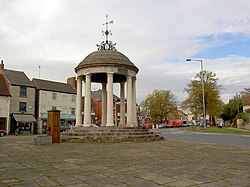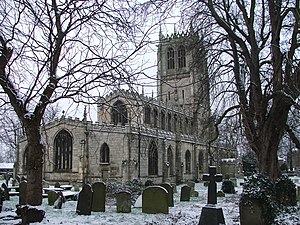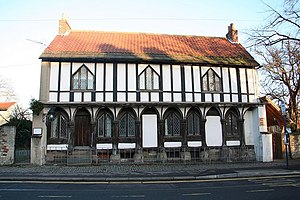Tickhill: Difference between revisions
Created page with '{{Infobox town |name=Tickhill |county=Yorkshire |riding=West |os grid ref=SK592931 |latitude=53.43049 |longitude=-1.11348 |population=5,301 |census year=2001 |post town=Doncaster…' |
mNo edit summary |
||
| (One intermediate revision by one other user not shown) | |||
| Line 3: | Line 3: | ||
|county=Yorkshire | |county=Yorkshire | ||
|riding=West | |riding=West | ||
|picture=The Market Cross Tickhill - geograph.org.uk - 586126.jpg | |||
|picture caption=The Buttercross, Tickhill | |||
|os grid ref=SK592931 | |os grid ref=SK592931 | ||
|latitude=53.43049 | |latitude=53.43049 | ||
| Line 14: | Line 16: | ||
|constituency=Don Valley | |constituency=Don Valley | ||
}} | }} | ||
'''Tickhill''' is a small town in the [[West Riding of Yorkshire]], on the border with [[Nottinghamshire]]. It had a population of 5,301 in 2001. | '''Tickhill''' is a small town in the [[West Riding of Yorkshire|West Riding]] of [[Yorkshire]], on the border with [[Nottinghamshire]]. It had a population of 5,301 in 2001. | ||
There are many traditional shops in Tickhill including | There are many traditional shops in Tickhill including two butchers. There is also a popular 'millpond' with a wide variety of ducks that is popular with the local residents. | ||
The town lies eight miles south of [[Doncaster]], between [[Maltby, Yorkshire|Maltby]] and [[Harworth]], on the busy junction of the A631 and A60 roads, and adjacent to the A1(M). The [[River Torne]] passes close to the south-east of the town where it is the boundary between Yorkshire and Nottinghamshire, eventually meeting the [[River Trent]]. | The town lies eight miles south of [[Doncaster]], between [[Maltby, Yorkshire|Maltby]] and [[Harworth]], on the busy junction of the A631 and A60 roads, and adjacent to the [[A1(M) motorway|A1(M)]]. The [[River Torne]] passes close to the south-east of the town where it is the boundary between Yorkshire and Nottinghamshire, eventually meeting the [[River Trent]]. | ||
Notable buildings in Tickhill include the substantial ruins of [[Tickhill Castle]] which contain a private residence leased by the Duchy of Lancaster, St Mary's Church – a large 13th century parish church, the parish rooms, an old hospital called St | Notable buildings in Tickhill include the substantial ruins of [[Tickhill Castle]] which contain a private residence leased by the Duchy of Lancaster, St Mary's Church – a large 13th century parish church, the parish rooms, an old hospital called St Leonard's, and the [http://www.geograph.org.uk/photo/386725 Buttercross]. | ||
==Name== | ==Name== | ||
| Line 39: | Line 41: | ||
Initially, Tickhill was a successful new town. It gained a friary and St Leonard's Hospital. The Guild of St Cross was established in the town, and it is believed to have acted as the village's main governing body. In 1295, Tickhill sent two members to Parliament as a borough, but did not do so subsequently.<ref name="hey" /> | Initially, Tickhill was a successful new town. It gained a friary and St Leonard's Hospital. The Guild of St Cross was established in the town, and it is believed to have acted as the village's main governing body. In 1295, Tickhill sent two members to Parliament as a borough, but did not do so subsequently.<ref name="hey" /> | ||
The town inserted its name into that of the Strafforth and Tickhill | The town inserted its name into that of the [[Strafforth and Tickhill]] Wapentake of the West Riding. | ||
===Sixteenth century=== | ===Sixteenth century=== | ||
| Line 46: | Line 48: | ||
The Tickhill Psalter, an outstanding mediæval illuminated manuscript was made in the Worksop Priory Nottinghamshire, is currently on display in New York.It is named after John de Tickhill, born locally and who was made Prior of Worksop in the 14th century. | The Tickhill Psalter, an outstanding mediæval illuminated manuscript was made in the Worksop Priory Nottinghamshire, is currently on display in New York.It is named after John de Tickhill, born locally and who was made Prior of Worksop in the 14th century. | ||
===Twentieth | ===Twentieth century=== | ||
Tickhill and Wadworth railway station was open from 1910–29. There | Tickhill and Wadworth railway station was open from 1910–29. There has been much debate whether to reopen this station. | ||
==The Castle== | ==The Castle== | ||
Latest revision as of 14:08, 1 October 2019
| Tickhill | |
| Yorkshire West Riding | |
|---|---|
 The Buttercross, Tickhill | |
| Location | |
| Grid reference: | SK592931 |
| Location: | 53°25’50"N, 1°6’49"W |
| Data | |
| Population: | 5,301 (2001) |
| Post town: | Doncaster |
| Postcode: | DN11 |
| Dialling code: | 01302 |
| Local Government | |
| Council: | Doncaster |
| Parliamentary constituency: |
Don Valley |
Tickhill is a small town in the West Riding of Yorkshire, on the border with Nottinghamshire. It had a population of 5,301 in 2001.
There are many traditional shops in Tickhill including two butchers. There is also a popular 'millpond' with a wide variety of ducks that is popular with the local residents.
The town lies eight miles south of Doncaster, between Maltby and Harworth, on the busy junction of the A631 and A60 roads, and adjacent to the A1(M). The River Torne passes close to the south-east of the town where it is the boundary between Yorkshire and Nottinghamshire, eventually meeting the River Trent.
Notable buildings in Tickhill include the substantial ruins of Tickhill Castle which contain a private residence leased by the Duchy of Lancaster, St Mary's Church – a large 13th century parish church, the parish rooms, an old hospital called St Leonard's, and the Buttercross.
Name
"Tickhill" is an Old English place-name but of uncertain original meaning: suggestions are Ticce hyll ("Kid hill", from the goats grazed on the rough pastures here) or Tican hyll; "Tica's hill", if ever there was a man named Tica.
The village is not recorded in the Domesday Book but was recorded as Tikehill at some time in the 12th century.[1]
History
Middle Ages
Shortly after the Norman Invasion, William the Conqueror gave the lands around Tickhill to Roger de Busli, who built a castle on a small hill.[2] Richard de Busli, grandson of Roger's brother Arnold, co-founded nearby Roche Abbey with Richard FitzTurgis in 1147.

During the Middle Ages, Tickhill was the second most important town, after Doncaster, in this part of Yorkshire. The Domesday Book lists the settlement under the former estate centre at Dadsley, now lying on the northern edge of the village. Dadsley was served by a church atop All Hallows Hill, which by 1361 had been downgraded to a chapel. Evidence suggests that the chapel was unused after the Reformation, and was razed in the mid-17th century.[2]
The town grew up around Tickhill Castle, and St Mary's was built soon after to replace All Hallows as the village's main church.[2]

Initially, Tickhill was a successful new town. It gained a friary and St Leonard's Hospital. The Guild of St Cross was established in the town, and it is believed to have acted as the village's main governing body. In 1295, Tickhill sent two members to Parliament as a borough, but did not do so subsequently.[2]
The town inserted its name into that of the Strafforth and Tickhill Wapentake of the West Riding.
Sixteenth century
As castles declined in importance during the mediæval period, so did Tickhill. By the 16th century, only a hall was occupied on the castle site, but the market and an annual fair on St Lawrence's Day survived. A little trade was gained from its position on the main road to Bawtry. In 1777, a butter cross was erected in the marketplace in an attempt to revive the weekly market, but this ceased in the 1790s.[2]
The Tickhill Psalter, an outstanding mediæval illuminated manuscript was made in the Worksop Priory Nottinghamshire, is currently on display in New York.It is named after John de Tickhill, born locally and who was made Prior of Worksop in the 14th century.
Twentieth century
Tickhill and Wadworth railway station was open from 1910–29. There has been much debate whether to reopen this station.
The Castle
Tickhill Castle was built by Roger de Busli, one of the most powerful of the first wave of Norman magnates who had come to England with William the Conqueror. The castle had an eventful history in national life. It was held for the usurping prince John against his brother King Richard I, when the latter returned from abroad in 1194, after his absence on crusade, was the site of a three-week siege during baronial conflicts in 1322 and in the civil war of the 1640s its importance as a local centre of resistance led to its ‘slighting’ (intentional disabling) by Parliament after the defeat of the royalist forces there in 1648. (Conisbrough, long disused as a fortress by this time, escaped such a fate.)
Today Tickhill castle remains an impressive ruin, retaining its Norman gatehouse, built in 1129–1130, the foundations of the 11-sided keep (one of only two in the world) on a mound 75 feet high, built in 1178-9 on the model of the keep at Conisbrough, substantial defensive ditches, some parts of which remain as a moat, and walls enclosing an inner courtyard covering 2 acres.
Outside links
- Information on Tickhill from GENUKI
- Tickhill & District Local History Society
- Tickhill Online
- Riding club
- Tickhill Today
- Tickhill video postcard
- Rotherham Web